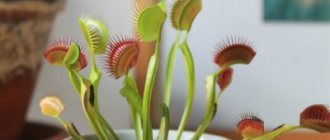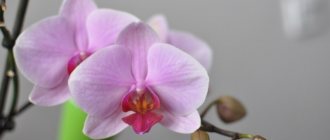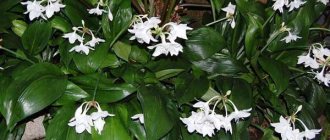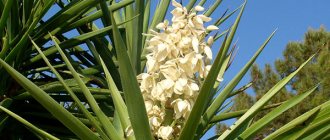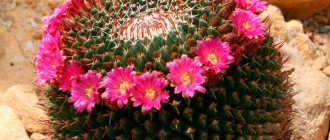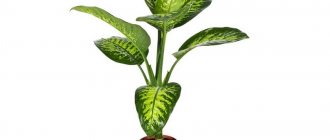Description of decorative aeschynanthus
Residents of Asia, where this bright bush can often be seen, ironically call it a “lipstick flower.” The explanation for this nickname lies in the appearance of the bracts and the purple petals visible from them.
A description of its distinctive features will help to form a general idea of the decorative aeschynanthus. This plant is one of the perennial evergreen subshrubs, which with considerable effort is adapted to home conditions. The climbing stems are decorated with fleshy bright green leaves located opposite each other on short cuttings. In size, the leaf plates barely reach 3 cm in width and up to 10 cm in length.
An adult plant is not large in size, since its height ranges from 40 to 70 cm. Due to the “creeping” branches, hanging pots or cache-pots are ideal for it, which will emphasize all the beauty and grace of the bush.
The indoor ornamental plant Aeschynanthus simply stuns with cascades of orange or purple flowers, crowning the ends of its climbing stems. Outwardly, they resemble curved tubes with a velvety surface. The inflorescence contains from 5 to 10 bright flowers and delights with its long flowering - from June to the end of September. It is precisely because of the attractiveness and charm of this flowering bush that flower growers try to satisfy all its “whims” and requirements as much as possible.
To be convinced of what has been said, take a look at the photo of a bright indoor aeschynanthus, which will not leave anyone indifferent, captivating with its beauty and rich palette of purple-scarlet colors:
Features and appearance
The natural habitat is the forests of south-eastern Asia. Epiphyte - in nature clings to tree roots, bark, snags, and stones. The stems are creeping, up to half a meter long, covered with small fibers. The leaves are thick and contain a reserve of moisture in case of drought. On the surface of the leaves there is a waxy coating that prevents the evaporation of moisture. The color is usually monochromatic - green of varying intensity. Less common are variegated varieties in a combination of green and red.
As a houseplant, aeschynanthus requires conditions close to its natural climate. Grown as an ampel crop. In summer, red or red-orange flowers bloom in clusters at the ends of the shoots. Each flower is covered with a purple-brown bract. The flowers themselves are tubular with a protruding pistil and long stamens of different colors. The flower clusters have an interesting shape and are directed upwards.
Important! Aeschynanthus is often confused with another tropical flower - columna. They are similar not only in appearance, but also in terms of growing conditions. A clear difference appears during flowering. Columnaea flowers are not collected in clusters at the ends of the shoot, but bloom singly along its entire length.
Stems. The plant has many stems, the length of which reaches an average of 50 cm. Each stem is decorated with oppositely located fleshy and leathery green leaves. The length of the leaves is approximately 8-12 cm. At the ends of the stems there are beautiful flowers in the form of tubes. They are also called “lipstick” because of their striking similarity. Flowers are collected in a single bunch. The color of the flower depends on the variety; it can be dark red, yellow, bright red, orange or red-pink. The most interesting thing is that the flowering period of aeschynanthus lasts from June to October.
Types and varieties of Eschynanthus: description and photos of varieties at flowering time
To date, more than 80 species of liana-like aeschynanthus have been cultivated, despite the difficulties in breeding and growing this elegant representative of the Gesneriev family. However, in specialized stores selling indoor plants, only a few of its most established varieties are found.
So, you can buy:
Aeschynanthus speciosus (orange-red)
Aeschynanthus hiltiebrandtii (red)
Aeschynanthus tricolor (brown-red)
Also various attractive hybrids:
Beautiful (speciosus) is the most famous type of decorative aeschynanthus.
When looking at the photo with his image, the reason for such a “praiseful” name becomes clear:
Chic external parameters make it an excellent decoration for any interior. The curly flexible branches of the flower are quite long - about half a meter. In an adult bush, they begin to become a little coarser at the base, becoming covered with woody bark. The leaves are densely “strung” on oval-shaped shoots and a juicy olive color. During flowering, this liana-like subshrub is decorated with amazing inflorescences, in which 8-10 tubular flowers of orange-red color are connected into a delightful bouquet.
Close in appearance and name is another charming variety of climbing aeschynanthus with an equally intriguing name - beautiful (pulcher). The main difference between this species and its predecessor is the smaller size of both the foliage and the inflorescences themselves. The range of shades in which the flowers are “painted” covers brighter red and fiery tones.
The Lobbianus aeschynanthus (lobbianus) stands out among its relatives for its exquisite flowering. This species, with its bright red inflorescences, fills the interior of the room with a pleasant exotic atmosphere and surprises with a charming play of colors. Thickly mixed small, deep green leaves add to the overall appeal of this homemade "beauty." Flowering duration is about 3-4 months annually.
Marble (marmoratus) type of indoor aeschynanthus, the photo of which justifies its name, is a bright decorative representative of the Gesneriev family:
Its foliage plates are distinguished by a glossy surface and green and yellow abstract patterns that are very similar to marble. It is the foliage of this plant that is considered the main advantage and decoration, since small green flowers with miniature brown spots are not particularly attractive.
Aeschynanthus Hildebrandtii is a beautiful home flower with a thick, juicy green leafy crown, among which one can see sophisticated curved inflorescences of a noble burgundy color. This species is less demanding of its habitat, which explains its popularity among gardeners.
Twister is a “curly” variety of exotic aeschynanthus, whose photo will confirm the harmonious combination of emerald glossy leaves with ruby flowers.
Curvature - this feature is characteristic of both inflorescences and leaves and climbing branches. Such pets will look very impressive in hanging pots, attracting the admiring glances of connoisseurs of beauty.
Rasta is another type of aeschynanthus with curled leaves in dark green colors. They are densely placed on shoots weaving towards the bottom. From May to September the plant is framed with rich red inflorescences.
variety (karolina) is distinguished by its small, compact bush size, on which each new leaf rises slightly and stretches upward. The leaf blades have an oblong oval shape, reaching about 7-8 cm in length. Graceful flowers are painted in rich shades of noble burgundy.
Modern breeders have developed varieties and improved hybrids for most species of aeschynanthus. The main goal of such efforts is to obtain brighter and longer flowering with an abundance of all kinds of colors of inflorescences.
A few examples of common varieties of decorative aeschynanthus:
"Tricolor" - yellow-red striped inflorescences.
"Fulgens" - variegated pink flowers.
"Grandiflora" - owners of fiery orange flowers.
"Bella Donna" - deep red inflorescences.
"Tamara" - leaves and flowers with silvery hairs.
"Topaz" - unusual yellow color of inflorescences.
Take a look at the photos of these beautiful varieties of aeschynanthus, and you will certainly receive true aesthetic pleasure:
Such plants are evidence that nature is a talented master, and each of her creations is a masterpiece!
Varieties
There are several varieties of Eschynanthus:
- Aeschynanthus marbled has long stems and wonderful 10-centimeter waxy leaves, yellow-green above, brown and marbled below. The flower tube is green with spots.
- Lobba - comes from the island of Java. The stems are flexible, the leaves are small, dark green, elliptical in shape. Yellow flowers with a red corolla.
- Aeschynanthus magnificent - characterized by shoots 30-60 cm long. Fleshy leaves, 10-12 cm long, almost sessile, located opposite each other. 10-12 flowers on the shoots are combined into inflorescences. The corolla is bright orange, with a reddish crescent-shaped spot on all five lobes of the calyx.
- Aeschynanthus beautiful - the leaves are smaller than those of the Magnificent, have reddish edges. The calyx is bare and green, the bottom is red. The corolla is 3 times longer than it.
- Eschenanthus Mona Lisa - can most often be found in home floriculture. In comparison, it’s not very capricious. But special care is undoubtedly needed. Climbing stems hanging attractively from hanging pots are a stunning sight. The flower and corolla are red, but in different shades. You can see what Aeschynanthus Mona Lisa looks like in the photo. Buy - at any flower shop.
- Twister - its main difference is leaves that twist strongly. The flower has a bright orange or red hue. The stems are long, cast dark green, can be seen in the photo.
- Eschynanthus rocky (photo) - the shape of the leaves is very similar to oak, and the flowers have a pink-purple tone. Not everyone would risk buying one for breeding at home - it is very demanding in care.
- Carolina - it is distinguished from other varieties by its pubescent young leaves. With development they become long, elliptical in shape. Carolina blooms in a burgundy shade (photo).
Tips for caring for a houseplant Eschynanthus at home (with video)
The demanding nature of indoor aeschynanthus is known among specialists in the field of floriculture, but for many this is not a hindrance to growing it and admiring the beautiful bright inflorescences. It is possible to achieve such a result, the main thing is to understand the basic “requests” of the plant and create a comfortable growing environment.
First of all, it’s worth finding a suitable “corner” where a beautiful flower will feel comfortable, like at home - in the tropical forests of southern countries. The best location should be with bright light all year round, as the sun-loving member of the Gesneriaceae family is accustomed to “warming up” its glossy foliage under warm, indirect rays.
You should avoid direct exposure to sunlight for a long time, as this can lead to burns of deciduous plates. The eastern or western rooms of the apartment are ideal for the active growth and flowering of decorative aeschynanthus.
When placing a plant in a flowerpot or hanging pots, you should carefully study the area regarding the sufficiency of lighting, otherwise all efforts to decorate the room will end in a “fiasco” in a couple of days.
It is important to provide the necessary temperature conditions, taking into account the life cycles of the home flower. So, the temperature should be above 20°C - from spring to late autumn, when the plant is at the stage of active growth. In winter, during the period of bud formation, 4 weeks the temperature is about 15 °C.
Lower temperatures during the “quiet” season are one of the secrets of how to achieve rapid and abundant flowering of aeschynanthus in early spring.
- Humidity: High. If you spray this decorative flower more often on hot days, the foliage crown will be brighter and denser, and the likelihood of colorful inflorescences appearing is much higher. For irrigation, it is better to give preference to clean, settled water at a warm temperature.
- Substrate: Flower soil mixture with polystyrene chips, which is available in all specialized stores. For those who are skilled at preparing fertile soil on their own, it is necessary to mix peat and turf soil with the addition of sand in equal proportions. It is important to carefully check the resulting earthen lump for the absence of parasitic insects.
To obtain healthy flowering and glossy, succulent leaves, creating the conditions described will not be enough. It is important to provide systematic professional care for attractive aeschynanthus flowers, which in return will reward the owners with decorativeness and a charming appearance.
Watch a video with tips on proper care of aeschynanthus in normal home conditions from experienced gardeners, and you will be able to get comprehensive answers to many questions:
Location in the house of Eschynanthus
Since Eschinanthus loves light, but does not tolerate direct ultraviolet radiation, place it away from windows or choose windows on the western and eastern sides of the house and shade it, for example, with tulle curtains.
- Eschananthus will perfectly landscape any room in your home: living room, bedroom, bathroom, kitchen, nursery and even hallway.
- The only condition that the room must meet, in addition to good lighting, is relatively high air humidity.
- Therefore, the kitchen and bathroom in this case benefit from other rooms in the house.
But if the bathroom does not have enough light, then it is better not to place the aeschynanthus there, because it will not live long in artificial lighting. Eschananthus will look great in the bedroom, nursery and even in the hallway. But if you decide to place the plant in the hallway, where there is little light, revive it from time to time - place it in lighted places in other rooms, again not forgetting to shade it.
How to properly care for an aeschynanthus flower
The reputation of a demanding plant that has stuck with echinanthus frightens beginners and completely kills the desire to even try to grow it in their modest home greenhouses.
It is worth remembering that nothing is impossible! If you figure out how to properly care for the capricious aeschynanthus flower, then positive results will not be long in coming.
This climbing flower is one of the moisture-loving inhabitants of the tropics, but not everything is so simple with its irrigation. It is important not only to understand the frequency of water procedures, but also the requirements for the water itself.
According to experienced gardeners, the following watering is necessary: lightly moisten the root ball; In winter, water very rarely. In this situation, you need to find a “golden mean” between excess moisture in the soil and its dryness. Therefore, it is better to water frequently, but in small doses. This will prevent the accumulation of excess liquid in the soil and at the same time allow the substrate and roots to dry out.
Proper watering is the most important component of proper care for the beautiful aeschynanthus in normal home conditions. It is worth remembering the chemical composition of water, which should not contain a lot of calcium. Therefore, when preparing liquid for irrigation, it is necessary to settle and purify it.
Soil mineralization with the help of special complex mixtures has a beneficial effect on the growth and normal development of indoor flowers. This fertilizing should be carried out from March to the end of August - once every 2 weeks with small doses of fertilizer. However, it is important not to overdo it with their quantity, since the result will be the opposite of what was expected: the plant will begin to turn yellow and shed its leaves.
This component of professional care for the exotic indoor plant Aeschynanthus will influence the density of the inflorescences and the duration of their flowering. For many, it is the charming bright fiery flowers that are the main motivation to make significant efforts in the process of growing a green, whimsical “pet”.
Rules of care
It should be noted that it is not so easy to grow, let alone obtain, a flowering plant indoors. Eschynanthus refers to plants that require certain conditions to be observed when growing. Thanks to its beautiful foliage, aeschynanthus is kept in offices and apartments. Several cuttings are planted in one pot to obtain a dense bush with hanging branches. The plant looks very beautiful in a hanging pot. Below we will tell you how to properly care for Aeschynanthus in order to achieve frequent flowering.
Lighting
Eschananthus needs good lighting without direct sunlight. It is placed on windows facing east or west. You can place the pot on a south window, but you need to shade it from the sun's rays with a light curtain. Otherwise, the sun's rays will leave burns on the leaves. If there is not enough light, the plant will not please you with flowers. But when placing it on a windowsill, you must remember that the flower does not like drafts, but needs fresh air.
Temperature
To obtain a luxurious flowering plant, it is necessary to protect it from temperature fluctuations. The plant develops well in rooms with a temperature of 20 to 25 degrees. In autumn, it is necessary to ensure a slight decrease in temperature. In order for the plant to bloom in the spring, you need to lower the temperature to 15-18 degrees. At the same time, eschynanthus needs good lighting.
The temperature should not be allowed to drop below fifteen degrees, otherwise the leaves will begin to fall. If the correct temperature conditions are observed, flower buds will appear in late winter - early spring. You can begin to gradually increase the temperature.
Watering and humidity
Eschananthus needs the right combination of air humidity and watering. Water the flower only after the top layer of soil has dried a few centimeters. Excess water is poured out of the pan. If you allow the soil in the pot to dry out, the buds and flowers will begin to fall off. In summer, the flower is watered more often, and in winter - every other day after the soil dries out. With excessive watering, the leaves turn yellow and fall off.
Water used for watering and irrigation must be:
- settled;
- room temperature;
- soft.
Hard water can be softened by adding a few drops of lemon juice.
The leaves of the flower are able to accumulate moisture, so they tolerate dry air in apartments. But in the summer, it is recommended to spray the plant once or twice a day, avoiding moisture on the flowers. Water for spraying should also be warm and settled or filtered. In summer, you can give Eschynanthus a warm shower. In winter, the flower does not need spraying. You can place the pot in a container with wet expanded clay.
In spring and summer, eschynanthus needs feeding. Traditionally, fertilizers are used for flowering plants, which are applied along with watering once a week. The dose of fertilizer for eschynanthus is reduced by half.
Trimming
Over time, the leaves in the upper part of the plant fall off, which leads to the loss of its decorative effect. Therefore, it needs periodic pruning, which can be done before and after the flowering period. Long shoots are shortened by one third and dry leaves are removed. The tips of the shoots can be pinched.
This may be interesting: Complete classification of types and varieties of Violets (Saintpaulium)
Transfer
Transplantation of eschynanthus is carried out using the transshipment method. This procedure is carried out before or after flowering. The new pot should be a couple of centimeters larger in diameter. A layer of drainage is poured at the bottom to avoid stagnation of water in the pot.
Young plants are replanted every year. Large flowers are transplanted when the roots are visible from the drainage holes. Eschananthus feels comfortable in cramped pots.
The soil
The soil for eschynanthus should be loose and allow air and moisture to pass through. At the same time, it must be nutritious. Therefore, you can prepare it in two ways:
Add raising agents to ready-made purchased soil (universal):
- perlite;
- vermiculite;
- fine expanded clay.
Prepare the soil mixture yourself from the following ingredients:
- leaf soil (2 hours);
- peat (2 hours);
- sphagnum moss (1 hour);
- river sand (1 hour).
This mixture will allow the roots to “breathe”, and the sphagnum moss will protect the roots from rotting. You can add coconut fiber, shredded bark and charcoal. It is recommended to choose a pot for the plant that is wide but shallow.
Proper pruning of aeschynanthus
The presentable appearance of this tropical subshrub depends on how correctly it is pruned. These manipulations should be carried out:
- Immediately after flowering.
- To remove dried areas.
- After damage to branches by pests.
- For aesthetic purposes.
There are no requirements for the season when indoor aeschynanthus can be pruned, and such procedures are performed at any suitable time. But it is worth remembering that this green “pet” tends to age and lose its decorative effect in the 4-5th year of its life. And in such situations, neither fertilizing nor sanitary pruning can help. The only way out is to replace him with a new young representative of the Gesneriev family.
Growing Eschynanthus from Seeds
To get a full-fledged plant from very small, down-covered seeds, you will need a long period of time, patience, universal soil for seedlings, and a warm, well-lit place.
The method is often used for breeding purposes. Sowing is carried out at the end of February under cover and until seedlings appear, maintain humidity, ventilate, and remove condensation. The seedlings are gradually adapted to natural conditions, increasing the time without shelter. The grown seedlings are planted in a permanent place.
Why does eschynanthus turn yellow and shed its leaves: diseases and pests of the flower
An ornamental and attractive plant, if not properly cared for, makes this fact known through disease. Typical for Eschynanthus are:
- Yellowing and falling leaves.
- Lack of flowering.
- Brown spots on foliage.
- Shedding of flower buds.
- Rotting of the rhizome.
Each of these types of damage has its own symptoms, and if they are noticed in time, the treatment process will be much easier and more effective.
The reasons that lead to the glossy leaves of climbing aeschynanthus turning yellow will depend on the time of year and the life cycles of the flower. For the cool autumn-winter period of time, this situation is explained by inappropriate cold temperature conditions. But things are different if in the hot summer season the picture repeats itself, and the elegant aeschynanthus turns yellow and sheds its leaves. This phenomenon can be explained by the following reasons:
- Insufficient watering.
- Heat.
- Low level of air humidity.
All of these factors affect, first of all, the root system, which dries out and becomes unable to ensure the fulfillment of vital energy exchange processes in the plant.
The main secret of flowering in Eschynanthus lies in creating a cool temperature during the period of bud formation. In December, when this natural process occurs, it is important to maintain the temperature no higher than 16 °C. If you ignore this feature, then gardeners are unlikely to be able to admire the bright tubular flowers in the spring and summer.
In addition to the diseases described, aeschynanthus may have pests, including:
Aphid.
Scaleworms.
Thrips.
Such parasites are usually introduced from new soil, during replanting, updating the substrate, or feeding. In order to prevent this phenomenon, it is important to systematically inspect the plant and its soil for the presence of “uninvited guests.” As soon as parasites are detected, it is worth treating the foliage crown with insecticides.
It is worth fighting diseases and pests in the early stages, and it is better to prevent their occurrence with the help of proper care.
Errors in care and their correction
| Error | What to do? |
| Lack of heat - leaves fall in winter. | Raise the temperature above +16 degrees. |
| The flower is too dry, the leaves fall off in the summer. | Water more often. |
| The leaves turn yellow and dry out from the heat. | Shade the flower. |
| Light spots caused by sunburn. | Do not place in the shade, but protect from direct rays. |
| Slow growing - lack of nutrients. | Feed. |
Why do the leaves of Eschynanthus turn brown and fall off?
Damaged leaves of Eschynanthus turn brown and fall off as a result of improperly selected water for irrigating the soil. Not only its softness and purity are important, but also the temperature, which should be about 22-24°C. Therefore, if you provide proper watering, you can easily cope with such a disease or prevent it in the future.
The flowers of this charming indoor “pet” are especially tender, so if moisture gets on the graceful petals during watering, the entire inflorescence becomes covered with brown spots, withers and crumbles.
You should be very careful to avoid such unpleasant situations! Falling of flower buds can also occur due to a change in location, drafts and direct sunlight.
Rooting of the root system occurs as a result of “overflowing”, when drainage cannot cope with excess moisture, the soil remains in a “wet” state for a long time and gray rot develops. It is worth taking measures to eliminate it very quickly, otherwise the damage to the plant will be significant and incurable. First of all, it is worth stopping the irrigation of the flower and ensuring the natural drying of the earthen clod.
Propagation by cuttings
In Eschynanthus, propagation occurs by cuttings. To do this, the cuttings are cut from the stem, taking into account that there are buds and several leaves on it. We dip the cuttings in a growth stimulator and plant them in the prepared soil; we place moistened sphagnum moss at the very bottom of the pot. The temperature should be maintained at approximately 25 degrees. After rooting the plant, you need to give it the opportunity to get used to the growing conditions, and then you can transplant it into a permanent container and provide care for growing eschynanthus as for an adult flower.
Transplanting Eschynanthus: how to properly transplant a flower at home
Active growth of eschynanthus is ensured by transplantation, which should be performed regularly - once a year. However, to obtain excellent results from such manipulation, it is important to follow its basic rules and consistency.
For those who are trying to figure out how to properly transplant indoor aeschynanthus in familiar home conditions, it is necessary to understand the main nuances of the procedure. Transplantation period - in February / March or after flowering. Having selected a new container, slightly larger than the previous one, you need to carefully place the drainage, and only then plant the plant. It is important not to damage the fragile roots, so you should not clean them from the soil, but move them together with it into a pot. It will be enough just to add the substrate around the edges and gently press the flower.
Such actions are simple, so to the question of how to replant a climbing aeschynanthus, the answer will be laconic and simple - very carefully, without haste and fuss!
Transfer
It is carried out approximately once every 2–3 years. The young bush is replanted annually. Adult – as needed. It is convenient to combine with pruning to obtain new planting material.
The fact that the plant needs to change the substrate is indicated by roots peeking out of the drainage holes of the container.
How to replant eschynanthus?
The soil mixture must be completely disinfected. To do this, resort to calcination or treatment with any fungicides. If the plant is in good condition, and the lump is braided with roots, you just need to transfer it into a slightly larger container , and fill the voids with fresh soil.
Good drainage is done first. It will protect the roots from rot. Afterwards, the eschynanthus is watered and sprayed.
The pot should be placed in partial shade or in diffused light . In about a week, the flower will adapt and can be moved to a brighter place.
Note! You will have to tinker with neglected aeschynanthus. The earthen lump must be carefully separated from the root system. Trim off all damaged roots. Plant in fresh soil.
About supports
Epiphytes have a tendency to grow rapidly. In small apartments this can be a real problem. If the plants are planted in pots and their stems fall down freely, then support will not be needed .
Bushy species are increasingly found on sale. With age, their shoots lose elasticity and become brittle.
In order not to injure the flower, it is necessary to install a reliable support. Wire arches, circular structures made from wicker, or bamboo trellises are suitable. The shoots must be carefully tied or twisted around the supports, giving them the right direction.
Advice! It is better to curl the aeschynanthus counterclockwise. This way the process will be faster and safer for the plant.
Watering
When the aeschynanthus blooms, water it generously. Otherwise, water sparingly to keep the mixture moist, but allow the soil on top to dry out 1cm between waterings. When kept in moist heat, these plants have no dormant period and therefore require so much water throughout the year. They should not dry out during flowering.
To find out when and how to water a flower, gently press the soil. The top 2.5 cm layer of soil should be dry. Water more often in summer in hot weather. Leaves can also be moistened to improve air humidity.
It is always better to use tepid water rather than cold as the latter may cause spots on the leaves which may also turn brown.
Problems
If your aeschynanthus plant has lost a lot of leaves over the winter, prune it more sharply, cutting the stems 6 inches above their base.
Watch out for aphids that attack young leaves. These tiny, highly prolific insects feed by sucking plant sap. They form dense colonies on young shoots and under leaves, and also feed on stems, bark, roots and fruits of plants.
Treatment: Inspect the plant regularly for insects and use a suitable insecticide spray if necessary.
Scale insects are another pest that can damage Aeschynanthus when they are grown indoors.
Treatment: Spraying the plant with diluted horticultural oil or soap can be an effective treatment.
Falling flower buds or wilting leaves can be caused by lack of water during the growing season.
Processing: Immerse the pot in room temperature water for 10 minutes and then allow to drain. After this, adjust the frequency of watering.
Leaf drop and root rot can be caused by too much water in winter.
Treatment: Trim damaged roots and replant the plant in a well-drained soil mixture. Consider reducing watering.
The edges of the leaves turn yellow and new shoots fall off, this may be due to the fact that the air around the plant is too dry.
Treatment: Increase relative humidity with a humidifier or place a tray of damp pebbles under the plant pot and mist the foliage.
Do not move the plant after the buds have formed to prevent them from falling off.
Origin
The plant grows wild in the humid forests of Asia, from the Himalayas to Indonesia, where the vines can reach a length of up to three meters. By its nature, it is an epiphyte, that is, a plant that lives on trees and other plants without extracting nutrients from them.
About 185 species are known, all of them are hanging plants. Accustomed to a warm and somewhat humid atmosphere, the aeschynanthus plant thrives indoors, in the kitchen and bathroom.
Colors and shapes
The first thing you notice about Aeschynanthus is its intricate, uniquely layered, profuse foliage that cascades abundantly on all sides. This trailing plant also produces dark red flowers that are hidden in almost purple tubes. Before buying a flower, check out the photo of the aeschynanthus and you will be convinced of its beauty!
Unusual, slightly mysterious and with a touch of drama, this beauty's shape is best showcased when held tall to allow the antennae to dangle. The plant goes well with Columna, they look a little similar, but still very different.

